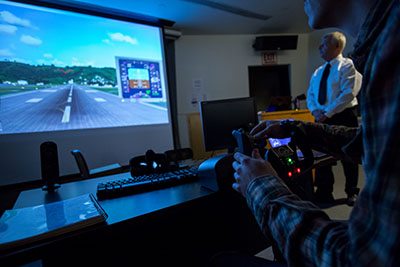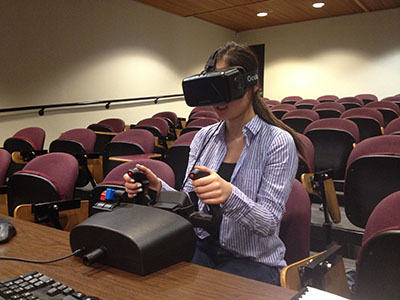Feb. 5, 2016

Whether with an eye towards an eventual career in flight, or simply out of curiosity about airline travel, 10 Amherst students spent part of their interterm taking the controls of a virtual Boeing 737.
Henry Parker Hirschel, retired instructor for the Steamship Authority in Woods Hole, Mass., has been teaching this course for the past nine winter breaks at Amherst. He considers this his "fun" course, paired with a more grueling course he teaches on celestial navigation, which studies the history, theory and techniques used to navigate the globe.
Not to say that the course on turbine flight is something to sleepwalk through. His students quickly find that attendance and attention to the 361-page Boeing manual are necessary to avoid mishap in the air.
Virtual air, that is: Hirschel, who flew sub-sonic fixed-wing multi-engine jet aircraft in the U.S. Air Force and was a beta tester for Sublogic’s “Air Transport Pilot,” teaches with the professional-grade Flight Simulator program.
This winter, students were in for a particular treat: taking the controls of the 737 simulator with a prototype Oculus Rift virtual reality headset. With their field of vision completely encased in the VR headset, the would-be pilots were able to step into a virtual cockpit and “fly” over a virtual Connecticut Valley on its approach to Bradley International Airport.

"I've been fascinated by aviation for many years, so having the chance to study the principles and procedures of jet-powered flight for a week was an opportunity I couldn't pass up," said Ian McClaugherty '19. "I hope to become a professional pilot after college."
The class reviewed basic principles of flight and jet-propulsion, focusing specifically on the Boeing 737.
"The engine that powers the 737, the 26,000-pound thrust General Electric CFM 56 turbofan, is the most successful in history," said Hirschel.
They examined the aerodynamic design and the history of turbojet and fanjet propulsion.
The course included a field trip to Bradley. At the virtual controls, participants assumed in-flight duties of captain and first officer, flying from Providence’s T.F. Green Airport and then landing in restricted visibility at Bradley. The course culminated in landing the Boeing over mountain terrain in the Virgin Islands on a stormy summer evening.
Nathanael Lane '18 said he signed up just for fun.
"I had heard good reviews from people who have taken it in past years," he said. "I feel that courses such as this one play deeply into the concept of liberal arts—exposure to a wide and diverse range of knowledge and experiences."